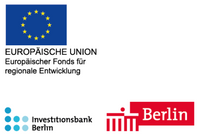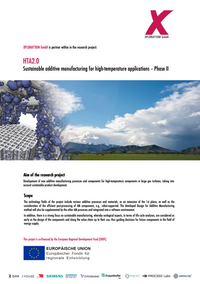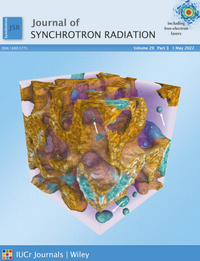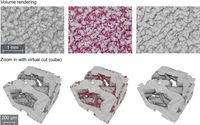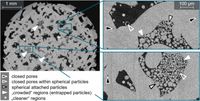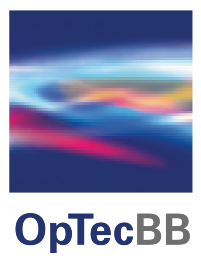Goodbye CHIC, hello Mitte!
01-2024: After more than 5 years at the Charlottenburger Innovations Center (CHIC) , we've relocated to Berlin-Mitte, just steps away from Berlin Hauptbahnhof. Thanks again, liebes CHIC team!
Come meet us in our new office:
Exciting news: The ProFIT research project 'MQ - Material Qualification Process for Laser Powder Bed Fusion Technology' is underway!
08-2023: The current high time expenditure in the so-called laser powder bed fusion (PBF-LB/M) is mainly due to the fact that the suitability of the parameter set cannot be immediately determined during the build process.
At the moment this can only be evaluated after the completion of the build process and metallographic analysis or CT examination. For this reason, there is a great need for systems and methods that improve monitoring and evaluation of the build process and the resulting material conditions already during the build process.
Project Objective:
- Develop or adapt models for thermal simulation that, on one hand, enable local temperature compensation for eddy current measurement, and on the other hand, on a finer spatial and temporal scale, form an expected value for the temperature near the melt pool, thus supporting absolute temperature measurement.
- Further develop the in-situ eddy current measurement methodology for PBF-LB/M systems.
- Develop radiation-based absolute temperature measurement for application in PBF-LB/M systems.
- Finally, correlate the calculated and measured temperatures, the electrical conductivities determined by the eddy current signals, and defects determined by high-resolution computed tomography. Synchrotron-based CT scans are used for this purpose, and the results are processed to allow conclusions to be drawn about the measured values of local temperature and eddy current sensors.
We are happy to announce the start of the BMBF Project:
Embedded Artificial Intelligence for quality assurance in Additive Manufacturing and advanced 3D material characterisation (AIQuAM3D).
08-2023: AIQuAM3D aims to further develop AI models and tools for quality assurance to apply them directly in the industrial environment. Based on the project results, embedded AI is intended to be used in AM process control in the future. At the same time, the results are an essential prerequisite for the extensive use of SR-μCT in industry and academic research.
Project partners: Fraunhofer IPK, Synchrotron SOLEIL, Novitom S.A.S.
Förderkennzeichen: 01IS23029 B
Start and Kickoff Meeting of the 2. phase of the research project Sustainable additive manufacturing for high-temperature applications (HTA)
07-2023: We are happy to announce our participation and the project start of the 2nd phase of the research project Sustainable additive manufacturing for high-temperature applications (HTA).
High-temperature applications involve the development and production of components that come into contact with the hot gas jet, which reaches temperatures of well over 1000 degrees Celsius, in high-efficiency gas-fired power plants.To ensure their operational efficiency and longevity, additive manufacturing is employed to realise inventive concepts that are unfeasible through conventional manufacturing methods.
The objective is to establish novel and sustainable additive manufacturing techniques and components for high-temperature elements within extensive gas turbine systems.
Our contribution involves leveraging our expertise to integrate the remarkable capabilities of synchrotron µCT into the project. In doing so, we aim to characterise additive manufacturing samples with high local resolution specifically aimed to assess surface properties.
Antragsnummer: 10194292
Xploraytion supports nature and climate protection activities of Förderverein Naturpark Barnim e.V.
01-2023: We primarily use large-scale research facilities for our investigations – throughout Europe. As a result, many kilometres have to be traveled each year from Berlin to Paris, Grenoble or Hamburg to carry out our measurements. To keep the ecological footprint of our company as small as possible and to actively do something for climate protection – preferably on site – we supported Förderverein Naturpark Barnim e.V. with a donation of 1200 €.
Förderverein Naturpark Barnim e.V. will maintain poplar rows, i.e. dying trees are cut down so that they remain a habitat for a long time. The deadwood that accumulates over time remains under the row of trees and binds carbon for years. Some of the carbon also passes into the soil in dissolved form. A hotspot of biodiversity is created in the deadwood – in the middle of the traditional agricultural landscape.
3 new publications in the month of June
06-2022: We are happy to announce three new publications:
- In a fruitful collaboration with TU Munich, TU Darmstadt and Merck KGaA:
Conductance Switching in Liquid Crystal-Inspired Self-Assembled Monolayer Junctions
- With the Department of Oral- and Craniomaxillofacial Surgery, Faculty of Medicine, Medical Center, University of Freiburg and the Department of Oral and Maxillofacial Surgery, Berlin Institute of Health, Charité—Universitätsmedizin Berlin:
Comparison of the 3D-Microstructure Between Alveolar and Iliac Bone for Enhanced Bioinspired Bone Graft Substitutes
- And the third publication together with the Center for Orthopaedics, Trauma Surgery and Rehabilitation Medicine, University Medicine Greifswald and BIH Center for Regenerative Therapies (BCRT), Berlin Institute of Health at Charité - Universitätsmedizin Berlin and Julius Wolff Institute, Berlin Institute of Health at Charité - Universitätsmedizin Berlin:
Synchrotron-based characterization of arthroprosthetic CoCrMo particles in human bone marrow
New publication in Journal of Synchrotron Radiation (JSR)
The resolution of a nano- or microCT scan is not the same as the voxel size, and it's important to choose the correct setup to maximise resolution and contrast.
In our paper featured on the cover of Journal of Synchrotron Radiation (that's a first!), we develop methods to measure image quality metrics directly from scans of a bone scaffold sample, and compare the performance of different setups in a real application, without scanning a test pattern or a 3D phantom. Big thank you to Julie Villanova, Max Langer, and Marc Bohner for this nice collaboration!
Please, follow this link to read our publication.
New publication in Additive Manufacturing
16-05-2022: Together with Siemens, we have published a study about the 3D micro-morphology of porous additively manufactured metal samples in prestigious Additive Manufacturing.
The paper quantifies metal powder remnants that are attached to surfaces of porous AM samples and discusses these remnants' potential role in future applications. Interestingly, the porosities of the AM samples produced by Siemens are the result of the manufacturing parameters only (e.g. hatch spacing) and not of a CAD-design. The work shows that scan strategy and process parameters have a major impact on the resulting morphology of the open porous structures. While the volume of the attached particles only contributes with a few % to the material volume, the impact on the material surface is quite significant as the surface increases by up to 50%. The presented findings may help to add another level of functionality to Additive Manufacturing of porous metallic samples.
Of course, Synchrotron µCT was exploited to obtain these findings and showcases the value it can provide for advanced 3D material characterisation.
Fig.1: 3D rendering of the original “raw” dataset (left) with highlighted powder particles (center) and the filtered structure’s surface (right) of sample 4. The bottom row shows a magnification of a cubic cut of the volume renderings seen in the upper row.
Fig. 2: Overview of different features identified in the samples.
Also watch our fly-through video!
New publication in Advanced NanoBiomed Research
29-12-2021: Have a look at our recent study on the interconnectivity and robustness of the bone cellular network using synchrotron nanoCT, published in Advanced NanoBiomed Research. A big thanks to all collaborating partners!
New publication in Analytical Chemistry
07-10-2020: We are proud to announce the publication of Nelson, Hesse et al. Distribution and chemical speciation of exogenous micro- and nanoparticles in inflamed soft tissue adjacent to titanium and ceramic dental implants
mobiLAB-4D - Mobiles Messsystem für die 4D-Qualitätskontrolle von Implantatoberflächen im Synchrotron
Laufzeit: 01.10.2019 -30.09.2022
Projektkurzbeschreibung
Die Anforderung an Implantatwerkstoffe werden aufgrund der steigenden Zahlen an Implantationen und aufgrund des höheren zu erwartenden Lebensalters der Patienten immer größer. Die Auswirkungen der Oberflächenstruktur von Implantaten auf klinische Komplikationen, wie beispielsweise Infektion oder mangelnde Osseointegration ist nicht abschließend untersucht. Insbesondere die Rolle von Nano- oder Mikropartikeln, die aus den Implantaten in das umliegende Gewebe gelangen, ist Gegenstand aktueller Forschung und Entwicklung sowie regulatorischer Neuerungen im Zusammenhang mit einer Risikobewertung.
Die lokale Exposition gegenüber metallischen Abrieb- und Korrosionsprodukten ist ein bekanntes Problem in der Zahnprothetik. Diese kann zu gesteigerter lokaler Inflammation oder zu Hypersensitivitätsreaktionen führen. Dabei treten Entzündungsreaktionen des umliegenden Gewebes (Periimplantitis) sowie Qualitätsverlust des periimplantären Knochens (Osteolysen) ein, wobei Osteolysen zu einem frühzeitigen Versagen des Implantates führen können. Vor diesem Hintergrund werden vier klinisch relevante Fragestellungen im Projekt adressiert:
- Freisetzung von Nanopartikeln
- Toxikologische Risikobewertung
- Ungenügende Osseointegration
- Periimplantitis
Das übergeordnete Ziel dieses Projektes ist eine signifikante Reduktion möglicher Komplikationen nach Einsetzen eines Implantates. Durch die Entwicklung neuartiger Implantatoberflächen sowie deren präklinische Prüfung hinsichtlich der Biokompatibilität soll dieses erreicht werden. Dazu werden eine Transporteinheit für organ-on-a-chip Systeme und eine Messkammer für zeitaufgelöste Messung im Synchrotron entwickelt.
Das Projekt ist auf Zahnimplantate fokussiert, die Ergebnisse sind jedoch auch auf andere titanbasierte Implantate übertragbar (bspw. Hüft- und Knieimplantate). Die Entwicklung neuartiger Implantatoberflächen in Kombination mit einer aussagekräftigen, präklinischen in vitro Prüfung kann als Vorbild für zukünftige regulatorische Prozesse dienen.
Projektpartner:
- Xploraytion GmbH
- Laser-Mikrotechnologie Dr. Kieburg GmbH
- Charité Universitätsmedizin
- Fraunhofer IPK
Assoziierter Partner:
- Universitätsmedizin Greifswald
- TissUse GmbH
- A.K.TEK Medizintechnik GmbH
Finanzierung:
Dieses Projekt wurde co-finanziert durch den Europäischen Fonds für regionale Entwicklung (EFRE).
Synchrotron-based analysis reveals implant-related particle exposure in bone and bone marrow
03-08-2020: We are very happy about the publication of our most recent paper in Advanced Science led by Charité Hospital Berlin and contribution from Xploraytion GmbH: Metal‐Specific Biomaterial Accumulation in Human Peri‐Implant Bone and Bone Marrow.
Publication in Advanced Science: https://doi.org/10.1002/advs.202000412
Excerpt of press releases: ESRF, Deutsches Ärzteblatt
"Metal particles abraded from tattooing needles travel inside the body"
27-08-2019: Together with colleagues from the Federal Institute for Risk Assessment (BfR), the European Synchrotron (ESRF), Physikalisch-Technische Bundesanstalt, Helmut Fischer GmbH and others we carried out a study which showed that, when using titanium-dioxide containing tattoo color, metal particles are abraded from tattoo-needles and travel inside the body. The study is widely covered in all media all over the world.
Publication in Particle and Fibre Toxicology: http://dx.doi.org/10.1186/s12989-019-0317-1
Excerpt of press releases: ESRF, New York Times, Zeit ONLINE, New York Post, Daily Mail, Spektrum.de, Scienmag, Tribune de Genève, Huffington Post
Publication in Investigative Radiology
We are proud to announce the publication of Wang, Hesse et al. "Increased Retention of Gadolinium in the Inflamed Brain After Repeated Administration of Gadopentetate Dimeglumine"
26-04-2019: XPLORAYTION GmbH contributed to a study within the Collaborative Research Center 1340: Highly sensitive synchrotron-based X-ray fluorescence analysis was applied and revealed hot spot regions of Gd in mice brain. This study might help to assess the risk of MRI contrast agent deposition in multiple sclerosis patients.
"Scientists find that nanoparticles from tattoos travel inside the body"
12-09-2017: We are happy to announce that we were part of a crucial study with the Federal Institute for Risk Assessment (BfR) on the transport of tattoo pigments (sub-micron organic pigments, heavy metals and titanium dioxide) from skin to regional lymph nodes by means of micro- and nano-XRF at the ESRF (Grenoble, France). The study was widely covered in all media all over the world. To view the press releases, please click in the logos below:
Scientific Reports publication: Synchrotron-based ν-XRF mapping and μ-FTIR microscopy enable to look into the fate and effects of tattoo pigments in human skin - Link to article
- TIME online in HEALTH RESEARCH: This Might Make You Rethink Getting a Tattoo - Link to article
- The Guardian online: Tattoo ink contaminants can end up in lymph nodes, study finds - Link to article
- phys.org in nanotechnology: Nanoparticles from tattoos circulate inside the body, study finds - Link to article
From the ESRF website:
24-07-2017: "Up to half of all dental implants placed worldwide develop an inflammation at some stage. One of the possible reasons could be the release of particles from the implants into the surrounding tissue. In the first of a two-part experimental sessions, researchers from the Department of Oral and Maxillofacial Surgery (Freiburg University Hospital) and the company XPLORAYTION GmbH are trying to map and characterise the particle distribution in the peri-implant tissue regions. Link to article
XPLORAYTION GmbH is now member of OpTecBB e.V.
05-2017: From optecbb.de: Optec-Berlin-Brandenburg e.V. (OpTecBB) is the competence network for optical technologies and micro-system technology in the region of Berlin-Brandenburg. OpTecBB is an initiative of companies and scientific institutions in Berlin-Brandenburg who aim to explore and use the technology together. OpTecBB was founded on September 14th, 2000 by companies, research institutions, universities and federations supported by relevant ministries in Brandenburg and the Berlin Senate. Today, the association has approximately 100 institutional members.




